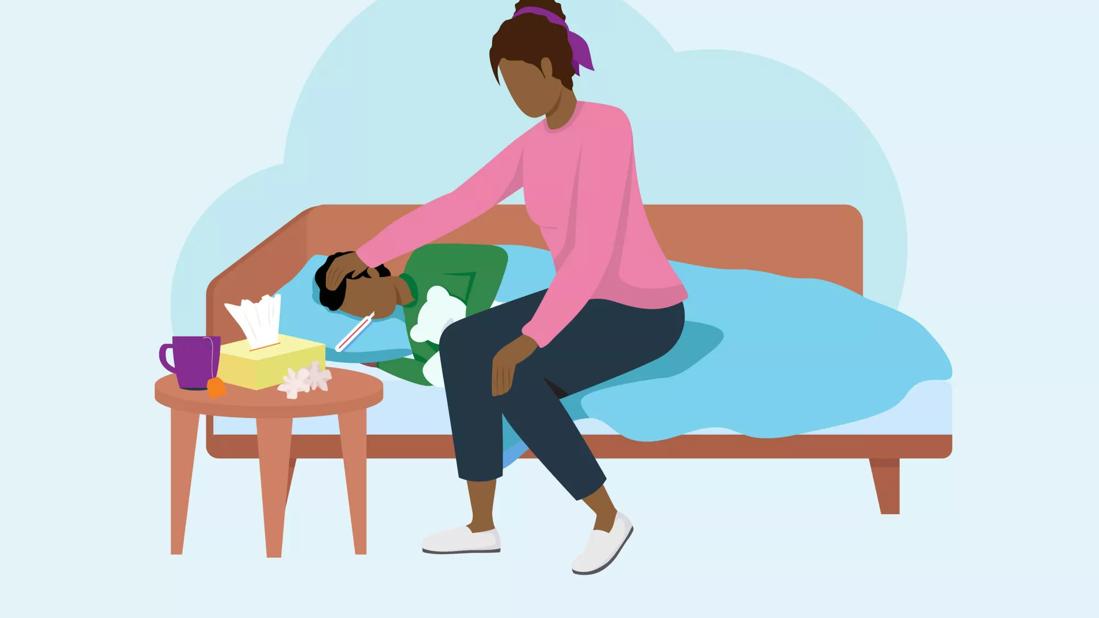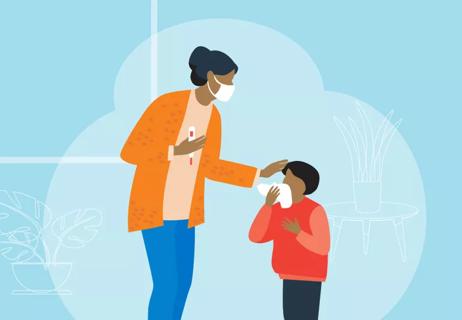It’s important not to give them fever-reducing medications right off the bat

You may not think of a fever as a good thing. After all, they can be kind of miserable, accompanied by body aches and chills and whatever the heck else comes with being sick. But fevers are actually your body’s way of putting up a fight.
Advertisement
Cleveland Clinic is a non-profit academic medical center. Advertising on our site helps support our mission. We do not endorse non-Cleveland Clinic products or services. Policy
“A fever is a sign that something is going on,” says pediatrician Maureen Ahmann, DO. “They stimulate our immune system to help fight infections, both viral and bacterial.”
And when your kid has a low-grade fever, your first instinct may be to give them an over-the-counter fever-reducing medication. But that’s actually not what doctors recommend.
Dr. Ahmann explains what to look for, when fever-reducing meds are the right move and why you should wait.
A standard body temperature is about 98.6 degrees Fahrenheit (or 37 degrees Celsius), while a fever is considered to be a temperature of 100.4 F (38 C) or above. You may also hear the term “low-grade fever,” which refers to anything in between those two numbers.
There are multiple types of thermometers on the market, including:
“In children ages 3 and under, the most accurate way to detect fever is to use a rectal thermometer,” Dr. Ahmann says, “but if you’re uncomfortable with that, use a forehead scanner or an axillary thermometer.”
Advertisement
Ear thermometers aren’t recommended for infants, as their ear canals are too tiny for an accurate reading.
When the thermometer shows that your child is running a fever, don’t jump right to giving them over-the-counter medicine.
“We sometimes hear from parents who give their children fever-reducing medications when their child’s temperature is, say, 98.9, or 99,” Dr. Ahmann notes, “and we really don’t recommend that.”
Here’s why you should hold off on giving your child medicine for a fever:
A fever doesn’t always equal a serious illness.
Kids are more prone to fevers than adults because their immune systems aren’t as well-developed. Whenever germs make an appearance, their little bodies hit back with full force, just to be on the safe side — which can bring on a fever that passes fairly quickly.
“We don’t recommend giving fever-reducing medications right away because fever in and of itself can help your child fight an infection,” Dr. Ahmann explains.
Kids need to go a full 24 hours without fever before they can go back to school or daycare (or anywhere else in public, for that matter). But when you give them fever-reducing medication, you can’t tell when they’ve started feeling better.
“Giving them fever-reducing medication can delay their return to school,” Dr. Ahmann says, “because once you stop giving the medication, you then have to wait a full 24 hours.”
Fever-reducing medication also reduces the pain your child feels from whatever condition is causing their fever, whether it’s body aches from the flu, a sore throat from tonsillitis or something else.
That may seem like a good thing — after all, no parent wants their child to be in pain. But sometimes, it can cause real problems.
“When a child has a fever but is acting normally, giving them a fever-reducing medication can actually mask their worsening symptoms,” Dr. Ahmann states.
Here’s an example: Let’s say your child is running a low-grade fever, and they’re acting normal but say their belly hurts a little bit. You give them a fever-reducing medication, which lowers their fever and lessens their pain — but because they’re on pain meds, they don’t realize (and, therefore, don’t tell you) that their belly pain has gotten worse.
“What if the cause of the fever and the pain is actually something like appendicitis?” Dr. Ahmann poses. “In that case, it takes doctors longer to diagnose the child’s underlying condition because their pain has been masked by fever-reducing medication.”
Advertisement
Your child’s fever isn’t always a cause for immediate concern — or even for immediate action. But how can you tell? As it turns out, there’s no straightforward playbook based on the numbers themselves.
“The first and foremost rule of a fever is to treat your child, not the number on the thermometer,” Dr. Ahmann advises.
She walks you through what to look for and when to call a doctor:
If your child seems to be OK — meaning they aren’t experiencing any other symptoms and don’t seem to be particularly bothered by their fever — then the best way to address their fever is just to keep an eye out for any escalating symptoms.
“Sometimes, a child can have a temperature of 102, and even though they’re not as active as much as usual, they’re otherwise looking good, they’re eating and drinking, and they don’t seem uncomfortable,” Dr. Ahmann says.
In these cases, you don’t need to actually do anything unless your child starts to feel sick or complain of pain.
“If they’re running around and playing, you don’t have to worry about it,” she adds, “but if they start to look or act sick, take their temperature again.”
If your child’s fever is accompanied by other symptoms, what to do next depends on what those symptoms are — and again, how they’re acting.
Advertisement
If they’re just complaining of pain — especially if it’s someplace specific, like their abdomen — then give your healthcare provider a call first.
But it may be time for a fever-reducing medication if they have a fever and seem sick, like if they’re:
“If you think getting your child’s temperature down a bit will help their pain or get them to drink fluids, then we advise it,” Dr. Ahmann says. “Again, it’s not about the number on the thermometer but about reacting to how your child is looking, acting and feeling.”
And even once your little one is feeling OK, remember: A child with a fever should always be kept home from school or daycare. After their fever breaks, wait 24 hours before sending them back to school. This ensures that they’re no longer contagious — a move that will keep other kids and families from experiencing the same feverish fate.
If your kiddo has a fever and isn’t feeling well, there are some things you can to do make them more comfortable while they ride it out and wait for the fever to break. Just as importantly, there are a few things you definitely shouldn’t do. Here’s what’s what:
Advertisement
A lot of the time, kids’ fevers pass quickly and don’t require any treatment. So, before you take your kiddo in to see the pediatrician, give them a call. “This allows us to guide parents along the way,” Dr. Ahmann says, “and after office hours, nurse call lines are a great option.”
Once you’ve connected with a healthcare provider, they’ll ask you specific questions about what’s going on and provide the guidance and reassurance you need.
Again, if your child’s symptoms seem mild, it’s OK to wait and see how things go. But call your healthcare provider right away if your child:
All of these can be signs that something more serious is going on.
“If your child has a very high fever or a fever that isn’t improving, call your primary care doctor to get advice on whether to come into the office or how to treat the fever at home,” Dr. Ahmann advises.
Learn more about our editorial process.
Advertisement

Any fever, especially one of 100.5 degrees Fahrenheit or higher, should trigger a call to your oncologist — and maybe a trip to the ER

A combination of rest, fluids and over-the-counter medications can help you feel better fast

When your body is fighting infection, your internal temperature rises as a defensive response

Most cases are mild and can be treated at home, but some situations may require medical care or a trip to the ER

It can cause alcohol poisoning and other serious health issues, especially in kids

Is it just a passing chill or something more serious?

What you need to know about these common misconceptions

Babies can get congested easily, but you can calm their cough by keeping them hydrated, using nasal drops and running a humidifier

Weight loss may cause loose, sagging skin and muscle loss to your rear

Several conditions, like vitiligo and fungal infection, can cause a loss of pigmentation, leading to white spots or patches on your skin